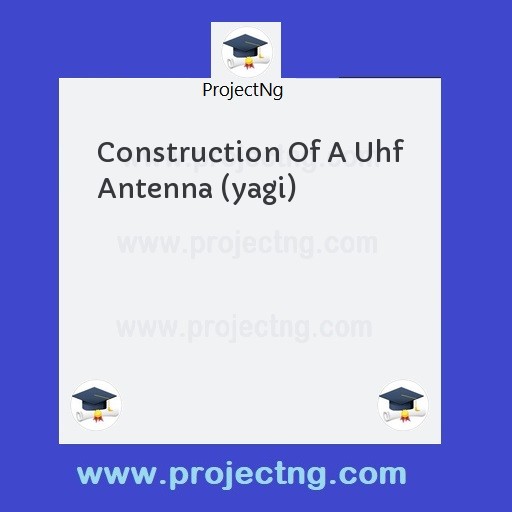Construction Of A Uhf Antenna (yagi)
Science Lab Technology Project Topics
Get the Complete Project Materials Now! »
CONSTRUCTION OF A UHF ANTENNA (YAGI)
ABSTRACT
An antenna is a device to transmit and/or receive electromagnetic waves (often referred to as radio waves). Antennas also radiate energy as possible because radiation is the primary function of the transmitting antenna. This Yaghi antenna constructed can operate with the range of UHF cannels or band. It has a high gain factor that can be in all channels such as UHF and VHF. The Yagi antennas have better selectivity.
Aluminum rod of 0.86m was used in the construction of this antenna a 75 n_ coaxial cable, BNC plug, screws and support grip were used in the construction. They were separately cut to required measurements. One wire of the coaxial cable was joined to the dipole, the others to the parasites (directors and reflectors). The spacing between the parasites and the dipole is 0.15 λ. The constructed antenna (Yagi antenna) was tested with a television set and it received UHF and VHF transmitted by Enugu State Broadcasting Service and Nigeria Television Authority.
Due to the omni directionality of the Yagi antenna, it was tuned too particular transmission area to have a better selectivity. The antenna has to be tuned to the transmission line to bring a clear reception.
TABLE OF CONTENTS
Title page
Certification
Dedication
Acknowledgement
Abstract
Table of contents
Table of figures
CHAPTER ONE
1.0 Introduction
1.1 Statement of problem
1.2 Aim and objective of the study
1.3 Justification of the study
1.4 Limitations of the study
CHAPTER TWO
2.0 Literature review
2.1 Brief history of the antenna
2.2 Types of antenna
2.3 Functions of the antenna
2.4 Parameters of the antenna
CHAPTER THREE
3.0 Materials and methodology
3.1 Materials
3.2 Specification
3.3 Construction
3.4 Diagram
CHAPTER FOUR
4.0 TESTING AND OBSERVATION
CHAPTER FIVE
5.0 CONCLUSION AND RECOMMENDATION
BIBIOLOGRAPHY
TABLE OF FIGURES
FIGURE ONE - SPATIAL ARRANGEMENT OF THE
ELEMENTS
FIGURE TWO - A DIPOLE ANTENNA AND IT’S RADIATION
PATTERN
FIGURE THREE - COMPONENTS OF THE YAGI ANTENNA
FIGURE FOUR - THE CONSTERUCTED YAGI ANTENNA
CHAPTER ONE
1.0 INTRODUCTION
According to Guglielino (1895), a twenty-year-old Italian inventor who crated a device that transmitted and received electromagnetic radio waves over a one-kilometer distance defined an antenna as a device, which transmits and receives electromagnetic waves (often referred to as radio waves). Later, improvement to his antenna work and development of a crude amplifier enabled him to receive a British patent for his wireless telegraph.
The Yagi antenna was invented at Tohoku University in Seudai Japan by Shintara (1926), his findings were later translated by his teach (Robert, 1928). He also came out with what he called the central concept of the Yagi – uda antenna named “Mutual Coupling”. It was further explained that the occurrence of this concept is as a result of two element coming close enough together that energy is transmitted or excited between the two elements and thereby induces current in the other elements.
Directors
 Reflector Forward direction
Reflector Forward direction
Driver
FIG. 1: SPONTICEL ARRANGEMENT OF THE ELEMENTS
1.1 STATEMENT OF PROBLEM OF THE STUDY
Due to the high cost of modern materials which cannot even offer the best services in so many cases, therefore, the need to use the locally available materials that can easily be afforded with clear and better selectivity arouse.
1.2 AIM AND OBJECTIVES OF THE STUDY
THE AIM
The aim of this work is to construct an antenna (Yagi antenna) that can operate within the range of UHF channels or band.
OBJECTIVES
The objectives of constructing this antenna are as follows:
1. Construct an antenna that can have a better selectivity.
2. To have an antenna with efficient impedance matching, that is an antenna, which matches the impedance of the transmission line with the receiver.
1.3 JUSTIFICATION OF THE STUDY
The significance of this project work was to enable students and the general publics know the usefulness of the Yagi-Uda antenna.
1.4 LIMITATIONS OF THE STUDY
The following limitations were encountered during the construction of this project work:
1. Selection of materials
Be the First to Share On Social

Enjoying our content?
Don't miss out on new videos! Subscribe to our YouTube channel for more awesome content.
Subscribe Now!













